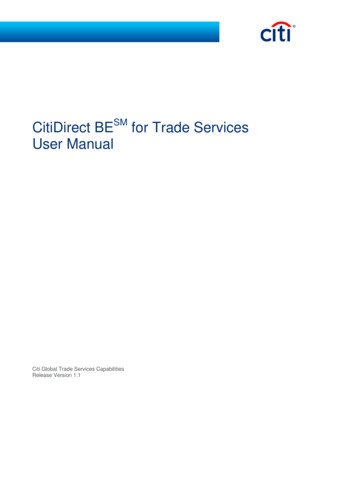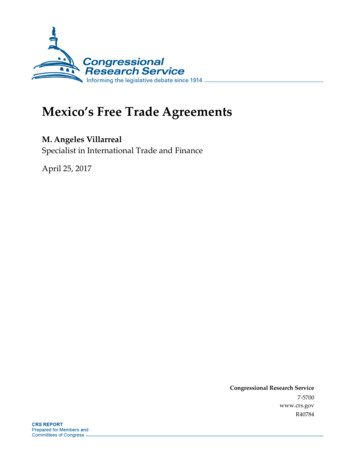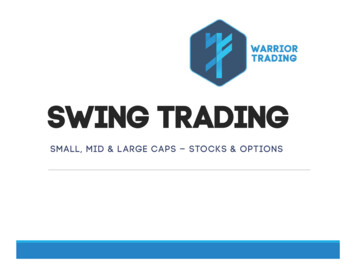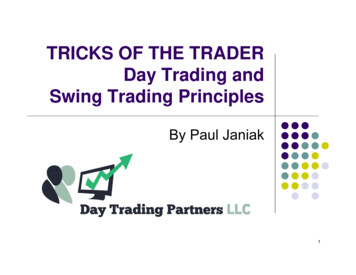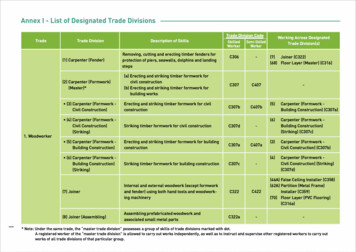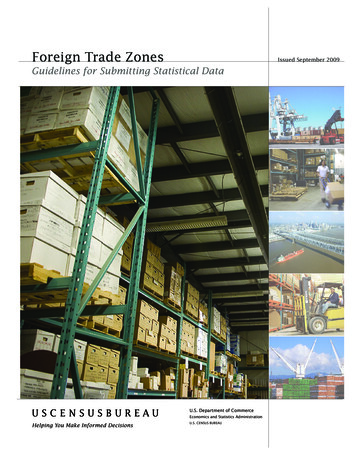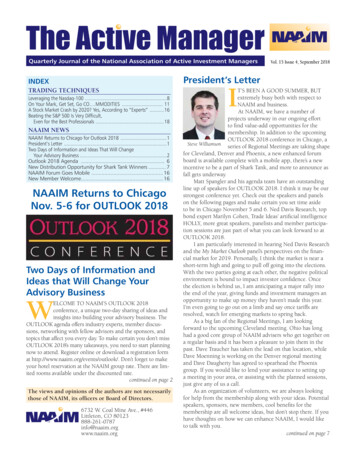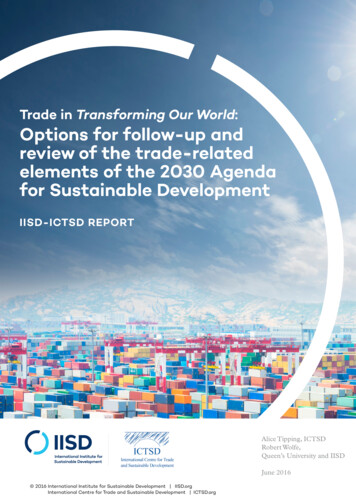
Transcription
Trade in Transforming Our World:Options for follow-up andreview of the trade-relatedelements of the 2030 Agendafor Sustainable DevelopmentIISD-ICTSD REPORTAlice Tipping, ICTSDRobert Wolfe,Queen’s University and IISDJune 2016 2016 International Institute for Sustainable Development IISD.orgInternational Centre for Trade and Sustainable Development ICTSD.org
Trade in Transforming Our WorldOptions for follow-up and review of the trade-related elements of the 2030 Agenda for Sustainable Development 2016 The International Institute for Sustainable Development andthe International Centre for Trade and Sustainable DevelopmentPublished by the International Institute for Sustainable DevelopmentInternational Institute for Sustainable DevelopmentThe International Institute for Sustainable Development (IISD) is one ofthe world’s leading centres of research and innovation. The Institute providespractical solutions to the growing challenges and opportunities of integratingenvironmental and social priorities with economic development. We report oninternational negotiations and share knowledge gained through collaborativeprojects, resulting in more rigorous research, stronger global networks, andbetter engagement among researchers, citizens, businesses and policy-makers.Head Office111 Lombard Avenue, Suite 325Winnipeg, ManitobaCanada R3B 0T4Tel: 1 (204) 958-7700Fax: 1 (204) 958-7710Website: www.iisd.orgTwitter: @IISD newsIISD is registered as a charitable organization in Canada and has 501(c)(3)status in the United States. IISD receives core operating support from theGovernment of Canada, provided through the International DevelopmentResearch Centre (IDRC) and from the Province of Manitoba. The Institutereceives project funding from numerous governments inside and outsideCanada, United Nations agencies, foundations, the private sector, andindividuals.Trade in Transforming Our World: Options for follow-up andreview of the trade-related elements of the 2030 Agendafor Sustainable DevelopmentJune 2016Alice Tipping, ICTSDRobert Wolfe, Queen’s University and IISDAcknowledgementsThis paper builds on a working draft published in 2015. This version issubstantially revised in light of the outcomes of the third internationalFinancing for Development conference of July 2015 and the UN Summit inSeptember 2015; and of the work of the UN Statistical Commission onindicators, and the Secretary-General’s January 2016 report on follow-up andreview. The authors are grateful for the helpful comments of many manycolleagues and officials.IISD.orgii
Trade in Transforming Our WorldOptions for follow-up and review of the trade-related elements of the 2030 Agenda for Sustainable DevelopmentForewordThe 2030 Agenda for Sustainable Development adopted in September 2015 commits all UnitedNations Member States to an ambitious and wide-ranging set of objectives requiring an integratedapproach to environmental, social, and economic development concerns. Its vision is nothing lessthan “transforming our world” and its structure and breadth send an important political signal aboutthe interrelated nature of global challenges. This universal and integrated framework for public policywill only succeed with the active engagement of the private sector and civil society.Trade and trade policy tools are referenced throughout the Sustainable Development Goals andeven more fulsomely in the Addis Ababa Action Agenda on financing for development. The manyreferences reflect the important contribution trade is expected to make to objectives as diverse asending hunger, the sustainable use of marine and terrestrial ecosystems, and ensuring healthy lives.How trade is managed and trade policy crafted will be crucial to the achievement of this new agendafor sustainable development.The 2030 Agenda is not legally binding. Instead, implementation is the responsibility of allstakeholders. For this reason the follow-up and review process, allowing all to track progress towardsfull implementation of the 2030 Agenda commitments, including those on trade, will be essentialto the framework’s success. Collecting the necessary information, interpreting and aggregating it atnational, regional, and global levels will be a real challenge and must involve all major stakeholders.It follows that we must make optimal use of existing policy monitoring and review systems whereverpossible, including those used in the trade-related institutions.This paper draws on the experience of our two organisations in trade, sustainable development,and international governance to provide an overview of how and where the trade elements of the2030 Agenda might best be reviewed. The paper maps where trade and trade policy are referenced,explicitly or implicitly, in the 2030 Agenda, identifying six clusters of commitments. It then suggestsa range of indicators that could be used to measure progress against these commitments andshows how existing policy review mechanisms could be used to review and galvanise progress. Thediscussion in the text is supported by a detailed annex that provides a range of options for bothmeasurement and review of the relevant elements. In identifying these options, the paper aims toinform discussions defining the follow-up and review mechanisms for the 2030 Agenda. It also aimsto help the trade policy community identify and fulfil its important role in securing the vision of the2030 Agenda and transforming our world. Lastly, the paper aims to provide a foundation for, and toprompt, further work in this area, including more detailed work on options for review mechanismsoutside the World Trade Organization. We would particularly welcome reactions to this paper andfurther work by governments and experts in developing countries, whose perspectives we feel havebeen under-represented in the debate so far.This paper was written by Alice Tipping, Senior Programme Officer at ICTSD, and Robert Wolfe,Professor of Policy Studies at Queen’s University and Senior Associate at IISD. Alice managesICTSD’s work on the 2030 Agenda, while Robert works on follow-up and review of the 2030 Agendaat IISD.We hope that you will find this study a useful contribution to your work.Ricardo Meléndez-Ortiz Mark HalleChief Executive, ICTSDExecutive Director, IISD-EuropeIISD.orgiii
Trade in Transforming Our WorldOptions for follow-up and review of the trade-related elements of the 2030 Agenda for Sustainable DevelopmentExecutive SummaryTrade and trade policy are central to transformingour world, the objective of the 2030 Agenda forSustainable Development. Trade can make a crucialcontribution to sustainable development objectives,including economic growth and poverty reduction,but requires a coherent policy framework that linkshelping businesses harness trading opportunities withmanaging the social, economic, and environmentalimpacts of trade. Ensuring policy learning about howtrade can contribute to the 2030 Agenda requiresrobust follow-up and review of the new globalframework.The first aim of this paper is to map where traderelated elements are found in the 2030 Agenda. Thesecond aim is to describe the architecture for followup and review that could support these commitments,and to map where it exists or could be built. The 2030Agenda in itself will not cause anything to change, letalone ensure policy coherence, but the review processmight.The contribution of trade to the 2030 Agenda isdiffuse, which means follow-up and review will be achallenge, but it need not be overly burdensome, andit will be useful. This paper presents options for howprogress towards these trade-related commitmentscould be reviewed over the next 15 years. Theprocess would provide information on progressbased on inputs from governments, civil society, andinternational organisations. This information would bereviewed through self-assessment by states themselves,through peer learning by other governments at theregional level (for example in United Nations regionalcommissions), and at the global level in multilateralagencies and the High-Level Political Forum, the apexof the follow-up and review process. The point of thesereview processes is not “evaluation,” but the sharing ofexperiences as a way to facilitate learning and policyimprovement.The paper identifies six clusters of trade-relatedelements in the 2030 Agenda. These elementsrange from improving access to trade finance tostrengthening the multilateral trading system.They include commitments to the reform ofperverse subsidies to agriculture, fisheries, andfossil fuels, and to ensuring that regional tradeand investment agreements are coherent withsustainable development. For each cluster, the paperidentifies options for indicators, where the necessarydata are already collected (if they are) and whereprogress against these political commitments couldbe reviewed. The analysis does not pretend to beexhaustive, but to provide a starting point for furtherdiscussion.The paper then presents the information from anotherperspective, focusing on the potential roles of thevarious peer review mechanisms, summarised in Box2. These mechanisms range from multilateral reviews,like the Trade Policy Review Mechanism of the WorldTrade Organization and UNCTAD’s voluntary policypeer reviews, to regional mechanisms that couldreview groups of states, like the Organisation forEconomic Co-operation and Development or regionaleconomic integration organisations like Asia-PacificEconomic Cooperation.The last part of the paper explains how the variousreports could be brought together. Given theprofusion of options for review mechanisms, aninter-agency task force on trade could provide ananalytical synthesis of reporting and reviews useful fordiscussions at national, regional, and global levels onthe interrelated effects and trade-offs between goals.IISD.orgiv
Trade in Transforming Our WorldOptions for follow-up and review of the trade-related elements of the 2030 Agenda for Sustainable DevelopmentBox 1: Selected examples of possible indicators, sources of information, and review mechanisms*Trade-related elementsPotential indicators and sourcesPotential review mechanismsCluster 1: Subsidies and commodities tradeAgricultural distortionsAgricultural subsidy levelsWTO and OECD agriculture committeesFossil fuel subsidiesIEA, OECD, IMF dataOECD, IEA country reviews, G20,UNFCCC, TPRMFisheries subsidiesWTO notifications, OECD dataWTO SCM committee and OECDFisheries committeeCluster 2: Access to water, energy, medicinesTRIPS flexibilitiesUse of TRIPS flexibilities for healthWTO TRIPS CouncilWater technologyTrade in related goods and services WTO CTE, APEC Committee on Tradeand InvestmentClean energy technologyTrade in related goods and services OECD, IEA Environment, Energy countryreviews, WTO Committee on Trade andEnvironmentCluster 3: Economic diversification, global value chains, trade finance, and facilitationEconomic diversificationLDCs’ export diversificationWTO TPRMRegional infrastructure, tradefacilitationWTO Trade Facilitation Agreementratifications, implementationWTO Trade Facilitation CommitteeAccess to trade finance, participationin GVCsDraw on work by WTO, regionaldevelopment banks, BIS WTOOECD TiVA databaseWTO Working Group on Trade, Debt andFinance OECD Trade CommitteeEnvironmental technologies forindustryTrade, tariffs on environmentallysound technologiesWTO CTE, TPRM APEC Committee onTrade and InvestmentTransparent, sustainable governmentprocurementMembership of WTO GovernmentProcurement AgreementWTO Committee on GovernmentProcurement, TPRMCluster 4: Illegal extraction and trade in natural resources, trade in hazardous chemicals and wasteEnvironmentally sound management ofwastesUNEP Global Chemicals OutlookBasel Convention Implementation andCompliance Committee, UNEPAccess and benefit-sharing regardinggenetic resourcesPermits submitted to Access andBenefit-Sharing Clearing-HouseConvention on Biological DiversityPoaching, trafficking of wildlifeProportion of traded wildlife thatwas poached, traffickedIUCN World Conservation Congress,CITES, WTO Committee on Trade andEnvironmentIncrease Aid for TradeWTO, OECD Aid for Trade dataGlobal Aid for Trade ReviewImplement S&D in WTOWTO Annual ReportWTO S&D Monitoring MechanismStrengthen multilateral trading systemWTO Bali, Nairobi packagesimplementationWTO General Council, TPRM, TradeNegotiations CommitteeIncrease developing country exportsDeveloping country, LDC exportsAverage tariffs faced by LDCsWTO CTD Sub-Committee on LDCsUNCTAD Trade and DevelopmentCommissionCluster 5: Multilateral trading systemCluster 6: Policy coherence for sustainable developmentStrengthen regional trade agreementsADB regional economic integrationindicatorUN Regional Commissions WTOCommittee on Regional TradeAgreementsPolicy space, investment agreementssafeguardsUNCTAD World InvestmentReportsUNCTAD Trade and DevelopmentCommission* This table provides extracts from the more extensive material found in the Annex.IISD.orgv
Trade in Transforming Our WorldOptions for follow-up and review of the trade-related elements of the 2030 Agenda for Sustainable DevelopmentTable of ContentsIntroduction.1Follow-up and review of trade in the 2030 Agenda . 21.0 Principles for Thinking about the Review Mechanism.42.0 Design Options for a Three-Level Review Process.73.0 Mapping the Trade-Related Elements of the 2030 Agenda.94.0 Mapping Trade-Related Review Mechanisms. 14References.20Annex: Review mechanisms for trade-related elements of the 2030 Agenda. 23IISD.orgvi
Trade in Transforming Our WorldOptions for follow-up and review of the trade-related elements of the 2030 Agenda for Sustainable DevelopmentAbbreviationsAAAAAddis Ababa Action AgendaADBAsian Development BankIUUillegal, unreported and unregulated(fishing)AfDBAfrican Development BankLDCsleast developed countriesAg-IMSWTO Agriculture InformationManagement SystemLLDCslandlocked developing countriesMDBmultilateral development bankAPECMFNmost favoured nationASEANAssociation of Southeast AsianNationsMoImeans of implementationMTSmultilateral trading systemBISBank for International SettlementsNGOnon-governmental organisationCITESConvention on International Tradein Endangered Species of WildFauna and FloraOECDOrganisation for EconomicCo-operation and DevelopmentRTAregional trade agreementS&Dspecial and differential treatmentAsia-Pacific Economic CooperationCPIACountry Policy and InstitutionalAssessmentCRTAWTO Committee on RegionalTrade AgreementsSADCSouthern African DevelopmentCommunityCTDWTO Committee on Trade andDevelopmentSDGsSustainable Development GoalsSIDSsmall island developing statesCTEWTO Committee on Trade andEnvironmentSMEsmall and medium-sized enterpriseDDAWTO Doha Development AgendaTFAWTO Agreement on TradeFacilitationDFQFDuty-Free Quota-FreeTiVAOECD-WTO Trade in Value AddedECLACEconomic Commission for LatinAmerica and the CaribbeanTPPTrans-Pacific Partnership agreementTPRWTO Trade Policy ReviewEIFEnhanced Integrated FrameworkTPRBWTO Trade Policy Review BodyFAOFood and Agriculture Organizationof the United NationsTPRMWTO Trade Policy ReviewMechanismG20Group of 20GVCsglobal value chainsTRIPSWTO Agreement on Trade-RelatedAspects of Intellectual PropertyRightsHLPFHigh-Level Political Forum onsustainable developmentUNUnited NationsICTSDInternational Centre for Trade andSustainable DevelopmentUNCTADUnited Nations Conference on Tradeand DevelopmentIAEG-SDGsInter-Agency and Expert Groupon SDG IndicatorsUNECEIEAInternational Energy AgencyIFIinternational financial institutionUNEPUnited Nations EnvironmentProgrammeIIAsInternational investment agreementsIISDInternational Institute for SustainableDevelopmentIMFInternational Monetary FundIPintellectual propertyIPOAIstanbul Plan of ActionITCInternational Trade CentreUnited Nations EconomicCommission for EuropeUNFCCCUN Framework Convention onClimate ChangeVNRVoluntary National ReviewWHOWorld Health OrganizationWIPOWorld Intellectual PropertyOrganizationWTOWorld Trade OrganizationIUCNInternational Union for Conservationof NatureIISD.orgvii
Trade in Transforming Our WorldOptions for follow-up and review of the trade-related elements of the 2030 Agenda for Sustainable DevelopmentIntroductionTrade and carefully designed trade policy can makea crucial contribution to supporting and integratingthe three dimensions of sustainable development– economic, social, and environmental – thatmake up the United Nations’ 2030 Agenda forSustainable Development (“the 2030 Agenda”).Trade-related elements perfuse both pillars of the2030 Agenda, the Sustainable Development Goals(SDGs) in Transforming our world: the 2030 Agendafor sustainable development (United Nations, 2015a),and the outcome document of the third Financingfor Development (FfD) conference, the Addis AbabaAction Agenda (AAAA).1 Trade-related targets areincluded in at least 12 of the SDGs. Some are goalspecific, but others see trade as a cross-cutting “meansof implementation” (MoI) relevant to the achievementof every goal. In order to realise this potential, tradeand other policies must reinforce each other and notwork at cross-purposes.This approach of integrating trade across thedevelopment agenda framework makes sense: itreflects the fact that trade has to be part of a coherentpolicy framework for sustainable development. Buttrade experts see imperfections in the 2030 Agenda.The SDGs focus on expanding exports, not obtaininghigh quality imports. Although they recognise, if onlyimplicitly, the importance of maintaining an opentrade regime that would allow domestic firms accessto low-cost inputs, they do not explicitly address thecentrality of services in accessing global value chains(GVCs). The SDGs also devote insufficient explicitattention to things like trade costs that are importantfor participation in GVCs (Hoekman, 2015). The2030 Agenda does recognise that with a universal,rules-based, open, non-discriminatory, and equitablemultilateral trading system, as well as meaningfultrade liberalisation (in the words of the AAAA, para.79), trade can serve as an engine of economic growth,not least by encouraging long-term private andpublic investment in productive capacities. Trade cancontribute to reducing poverty, the objective of1The UNGA resolution establishing 2030 Agenda incorporates the AAAA asan “integral part” of the 2030 Agenda (United Nations, 2015a, para. 40).This paper therefore looks at both the SDGs and the AAAA in its analysis ofthe trade-related elements of the 2030 Agenda.SDG 1, and promoting sustainable development.2According to the AAAA, with appropriate supportingpolicies, infrastructure, and an educated workforce,trade can promote employment, decent work, andwomen’s empowerment, reduce inequality, andcontribute to the realisation of the SDGs. Trade cantherefore contribute to the 2030 Agenda’s overallobjective of “transforming our world,” advancing bothhuman development and environmental protection.These aspirations may be feasible, in theory, butensuring that trade makes this contribution tosustainable development will take a concerted effortby many ministries within national governments,along with international organisations, civil society,and the private sector. It will require a coherentpolicy framework both to ensure businesses cantake advantage of trade opportunities and also tomanage the social and economic adjustments thatcan result from the competitive pressures of trade andthe environmental impacts of changes in economicactivity. Follow-up and review of the trade-relatedelements of the agenda is thus essential: the SDGsin themselves, and the trade-related elements, willnot cause anything to change, let alone ensure policycoherence, but the review process might.The contribution of trade to the 2030 Agendais pervasive but diffuse, as shown in the Annex,which means follow-up and review will be achallenge. Unlike many aspects of the 2030 Agenda,international trade is covered by numerous bilateral,regional, and multilateral agreements, which havetheir own review mechanisms.3 Our first aim withthis paper is to map where trade-related elementsare found in the SDGs and AAAA, and where it canbe reviewed. The analysis does not pretend to beexhaustive, but to provide a starting point for furtherdiscussion. Even a brief overview of where trade fits,in Box 1 above, shows the scope of the challenge.Although SDG 1 on ending poverty in all its forms does not contain explicittrade-related commitments, (with the possible exception of references tobasic services, discussed below) many of the targets and indicators includedin our analysis, such as the removal of distortions in agricultural markets orthe reduction of trade costs, could contribute to the objectives of this keySDG.3On the complexity of the global trade and investment architecture and itsrelationship to other institutions of global governance, including the 2030Agenda, see Deere Birkbeck and Botwright (2015).2IISD.org1
Trade in Transforming Our WorldOptions for follow-up and review of the trade-related elements of the 2030 Agenda for Sustainable DevelopmentFOLLOW-UP AND REVIEW OF TRADE INTHE 2030 AGENDAMechanisms for reviewing progress will be essential tothe interconnected challenges of achieving the 2030Agenda commitments. Having articulated the goals,states have to decide on whose agenda they shouldbe placed. Follow-up mechanisms will enable theworld to understand how things are working so thatprogramme adjustments can be made. Review will alsoallow states to learn from the experience of others;and shed light on whether states are individually andcollectively on track to meet their objectives.Achieving the 2030 Agenda will require coherentsystemic support, but most of the needed actionon sustainable development is national, even local.In this sense, the new accountability paradigm isbottom-up not top-down. The great achievement ofthe 2015 Paris Agreement on climate change is thatgovernments agreed to provide information on whatthey are doing on climate change, and to allow publicscrutiny of such action as well as collective review.The Paris Agreement requires governments to notifytheir nationally determined contributions (NDCs) tothe UNFCCC Secretariat, along with the steps beingtaken to implement those NDCs. These notificationprocesses provide an incentive for governments to actto fulfil the expectations created by the notification.Success will require robust surveillance of thesenotifications at the international level. This type ofreporting is about effort not outcomes, but a reviewprocess should also ask if objectives are being metand how to identify necessary follow-up. Follow-upand review of the 2030 Agenda requires comparingwhat we have achieved when measured against ourinitial aspirations and comparing ourselves to ourpeers. Review should ask if we are meeting our owngoals? Are we doing as well as similarly situatedcommunities or countries? Are we trying as hard aswe can? What can we learn from the achievements ofothers, and what can we learn from how others seeus? Are we collectively doing enough to support eachother in these efforts? What systemic follow-up isneeded and from whom? These are the questions thatcountries, and the international community, shouldask themselves.The purpose of review mechanisms is, thus, to allowconsideration of whether national law, policy, andimplementation are consistent with each state’saspirations for achieving the SDGs. But the 2030Agenda is also a universal agenda, in at least twosenses: the goals address all countries, at all levels ofdevelopment, and in many cases will require collectiveefforts to solve trans-boundary problems (like illegaltrade). Regional and global as well as national reviewwill be needed, therefore, because what happensin one part of the world has effects in others, andbecause of the interrelated effects and trade-offsamong the goals. Global review is also needed becausecountries in different regions or at the same level ofdevelopment may face similar challenges and, hence,have lessons to share.The 2030 Agenda is complex with many moving parts– 17 SDGs, dozens of targets, hundreds of indicatorsmonitored by dozens of international organisations,and hundreds of think tanks and NGOs. The mostimportant place to review implementation of theSDGs will be at the national level, and it will alreadybe a challenge to facilitate engagement by a rangeof actors at this level. Regional reviews will allowcomparison of similar countries, taking advantageof existing review mechanisms. The task of the newUN (United Nations) High-Level Political Forum(HLPF) on sustainable development, therefore, isto identify obstacles to implementation of the 2030Agenda and find ways to deal with them. Its roleinvolves orchestration, (Abbott and Bernstein, 2015),providing incentives and a framework for everyoneto participate, coordinating and encouraging theefforts of states, UN entities, business, NGOs – all thestakeholders who should be involved in the process.Review should identify achievements and criticalsuccess factors, support countries in making informedpolicy choices, and mobilise the necessary meansof implementation and partnerships. Mechanismsshould build on existing platforms and processes,and be rigorous and evidence-based. We havelooked for places where SDG-related data could beenhanced using existing reporting mechanisms, andwhere existing review mechanisms could continue tofunction as before, but with a stronger orientation tothe 2030 Agenda. The essential objective is to ensurethat the new system does not place an excessiveburden on states. Our second aim in this paper,therefore, is to describe the architecture for followup and review, and to map where its elements existor could be built. An overview of this part of themapping, also based on the Annex, is found in Box 2below.IISD.org2
Trade in Transforming Our WorldOptions for follow-up and review of the trade-related elements of the 2030 Agenda for Sustainable DevelopmentOutline of the argumentIn the first section of this paper, we discuss principlesfor thinking about review mechanisms, followed by abrief discussion in the second section of architecturaloptions for review. The third section reports on amapping exercise designed to show where tradefigures in the SDGs and in the AAAA, globalindicators endorsed in March 20164 and possiblesupplementary indicators, and where the necessarydata are already collected, if it is. The fourth sectiondescribes where trade-related follow-up and reviewmechanisms already exist, assessing where traderelated reporting can be discussed as a way to learnfrom the experiences of others, and benefit from thesuggestions of peers. While they overlap, the focusof section 3 is on the clusters of goals; the focus ofsection 4 is on the organisations. Sections 3 and 4draw on the same detailed mapping in the Annex,but use it in distinct ways. The profusion of optionsfor review mechanisms suggests that some kind ofanalytical synthesis of reporting at a global level wouldbe helpful. Without such an analytical synthesis, thevital contribution of trade to sustainable developmentmay be obscured. The conclusion, therefore, suggeststhat an inter-agency task force could be responsiblefor aggregation of all the trade-related reports for thepurposes of discussion of the interrelated effects andtrade-offs between goals.4The 47th Meeting of the United Nations Statistical Commission endorseda list of indicators for the SDG targets proposed by the IAEG-SDGs in itsreport of 19 February 2016 (United Nations 2016a).IISD.org3
Trade in Transforming Our WorldOptions for follow-up and review of the trade-related elements of the 2030 Agenda for Sustainable Development1.0 Principles for Thinking about the Review MechanismThe ultimate objective of follow-up and review,according to UN members, is “accountability to ourcitizens.” (United Nations, 2015a, para 74). Thepurpose is not a state giving an account of itself toforeigners, but a national process of learning; thegovernment, business, civil society of a nation askingthemselves whether as a country they are achievingtheir own objectives under the 2030 Agenda.Species of Wild Fauna and Flora (CITES).5 Inpractice the Secretary-General simply calls on otherbodies to review their own working methods to ensurethat they are supportive of the 2030 Agenda, althoughquadrennial comprehensive policy reviews (QCPR) ofoperational activities for development of the UnitedNations system may well review the performance ofUN entities.What principles and design considerations need tobe taken into account in establishing mechanisms?This paper relies on an analytic framework developedby the International Institute for SustainableDevelopment (IISD) (Halle and Wolfe, 2015; seealso Halle, Najam and Wolfe, 2014; IISD, 2014).It is based on questions to be asked in any analysisof a review mechanism (Mashaw, 2005). Askingthese questions helps us to be sure that we havesystematically considered all the salient factors. Thequestions are:2. By whom?2. By whom;In this paper we look only at self-assessment bygovernments and international organisations, reviewby governments of the actions of other governments,and the role of international organisations in supportof
Trade in Transforming Our World Options for follow-up and review of the trade-related elements of the 2030 Agenda for Sustainable Development Trade and trade policy are central to transforming our world, the objective of the 2030 Agenda for Sustainable Development. Trade can make a cr

